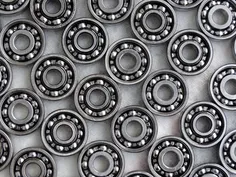One of the most frequently asked questions on the forums is how do I silence that Anet A8 fan noise?

I must admit this is one of the things i really dislike about this printer….
I am lucky and have it shut away in a separate room, but if it were in my bedroom or living room and on while sleeping or watching a movie then it would probably go into the bin…
Well this article will explore the options you have.
Which Anet A8 fan is installed?
When building the Anet A8 extruder assembly ( in this i include the filament drive motor and the hotend) you add two fans…
The one on the side, an axial fan, is used to keep the ‘cold’ end cold…
This is so the filament doesn’t distort before being fed into the hotend or it can cause jamming…
Or on a long print the way the hotend works ( a plug of filament forcing out the molten filament from the nozzle) can become too large for the motor to push against and again cause jamming…
So always fit this fan…
This one is on constantly from switch on….
This is a 40mm square ( approx) being 10mm thick – hence the designation 4010…
As the hotend doesn’t cool instantly i would suggest leaving the printer on until the hotend temperature reads lower than the transition temperature of the filament you are using ( 60C for PLA)…
The other is only used while printing…
This is a radial fan, it blows out the side…
And is controlled from the gcode for the print…
The amount of cooling is determined by what you set the cooling fan level to be…
This definitely needs to be installed along with the associated air feed to cool the extruded filament.
Just make sure that it isn’t blowing onto the hotend and causing issues with the heating of the filament…
But the two fans which come with the original printer and not the quietest…
What can you do to reduce the fan noise
At switch on of the anet a8 first time you may think you have bought a jet engine rather than a 3d printer…
It can come as a bit of a shock…
It’s sitting there doing nothing bar making this noise…
And that’ll be the extruder cooling fan….
I have seen a lot of posts saying that they disconnected this without issue…
But they don’t say
- whether their prints are long ones
- Whether their extruder stepper motor gets hot while printing
- Whether they have a skipping extruder on a long print…..
And this is important as it can affect your prints…
If the gear of the extruder motor gets above the glass transition temperature of the filament then it can start to distort it and not be able to feed it onto the hotend, or at least change the amount it feeds along, giving you a stringy effect only at elevated heights of print.
The fan that is fitted is a plain spindle one – where the pin for the spindle is not really fitted into any bearings only a sleeve with minimal lubrication at the start.
This lubrication is quickly squeezed out and under centrifugal force thrown out of where it is most needed…..
Some say you can add a drop of oil to reduce the noise, but this is more the noise present after the sleeve starts wearing…
The noise when you first get it is due to the fan blades and speed of the fans…
There are other designs of axial fan that are a lot quieter…
Once you are printing and your filament cooling fan kicks in at 100%, then again you wonder what you have bought…
The radial fan mounted on the front of the extruder assembly and directed down onto the extruded filament does make a lot of noise…
The fan type is a very efficient design, taking the air in from the rear ( or the face you see) with a sort of ducted fan, then pushing the air out of an aperture in the side of the casing…
This fan can be difficult to start at low pulse rates and may need a kick to get started slowly…
It is needed to improve the quality of the printing …
The hot filament needs to cool quickly or it may cause the under layers to distort or with bridges cause sag to the point of the filament breaking…
So what can you do about the fan noise…
Well you can replace the fans with other types…
What options do you have?
Essentially you have got three main options…
Replace like with like. So keep going with a sleeve bearing and all it’s problems…
These types of bearing will fail with no notice – so if you do go this way then keep a couple of spares in just in case.
They are the cheapest of the options.
Or look into a ball bearing fan- make sure you get the dual ball bearing as some of these are ball bearing on one side and sleeve bearing on the other.
The ball bearings or bb fans are more expensive but longer lasting.

They tend to be louder at the start than sleeved bearings, but will quieten down with run time.
The performance out of the box over time is good.
Again higher temperatures will prematurely wear the bearing due to loss of lubricant.
They have a more predictable failure mode by getting noisier before failing.
Or you can go with one of the newer hydrodynamic bearings.
Although these are essentially a sleeved bearing they have been modified to allow the lubricant to circulate.
They are the most expensive, due mainly to licencing fees.
They are very clever in the fact that they use the fans own rotation to create a flow of fluid around the bearings.
These are extremely quiet bearings and fans – almost whisper quiet.
These are the sorts of motors used in hard disc drives to make them quiet…
These bearings are sealed so should not lose lubrication over their lifetime. Even when running at elevated temperatures.
Failure of the seal is probably the major cause of fan failure…
You do have to watch out for some inferior types which are not so good, but generally all of these types are extremely quiet.
Another modified variation of this type of bearing is the sso bearing, where a magnet keeps the bearing centralized to further increase its lifetime and allow operation in any direction.
The sleeve bearing and bb fans are readily available in axial and radial modes.
But the hydrodynamic fans tend to only come in axial fans.
The actual volume of air throughput is lower with the hydrodynamic fans, so you may need a larger one to compensate.
But to get the silence I would go for a 40mm cooling fan and a 50mm duct fan.
What sort of noise reduction do i get from changing
The standard axial fan fitted to your anet a8 and other anets , like the a6 has a noise level of 25dBA…
Although i dispute this level, but don’t have a sound meter to test it…
25 dBA is pretty quiet…
A soft whisper at five feet is supposed to be 40dbA and this fan is a lot noisier than that…

What does that sound like, well as it is white noise ( noise across the whole spectrum) then it is a constant rain sort of noise with an open window and rain hammering down onto concrete…
You want to shut the window, but can’t – unless you switch off the printer…
If you choose the next level up – the ball bearing fan, you think it should be a lot quieter, but with metal contact it’s not..
The specs on the datasheet claims 31dBA, so about half the noise of the standard fan, but still intrusive…
Then you get onto the quiet fans…the hydrostatic fans – with or without magnets…
And these are claimed to be 17dBA…
And believe me they are super quiet…
I went for the Gelid fans rather than the Notua…
And even with these ( no magnets in these) the noise is whisper quiet…
Ok the fan blades are not rotating at such high speed, but the amount of air they are passing is equivalent to the standard …
The required supply voltage is the same at 12v, and the current is about equivalent – so the power consumption is about the same…it certainly will not overload your psu…
And they do the job…
So that is the one for the extruder – what about the filament cooling or blower fan…
Well there is no direct replacement for the radial fan as they don’t do one in that style…
But going for a slightly larger one ( 50mm fan) and printing a new mount and cooling nozzle you can happily replace the noisy radial fan with a whisper quiet gelid, or notua…
These do seem to startup at lower speeds than the originals as well so you can take advantage of the automatic cooling fan speed rather than manually setting it to 100%, as most of us do….
So now when you switch the printer on you may look twice or have to rely on the screen being lit to show that it is operating, seriously they are that silent…
My thoughts on the upgrade to silent fans
Do it…
Sorry if that was a little short, but it is well worth while doing this mod…..
And if you have the original anet a8 then one of the next mods to tackle is the song of the printer – the motor drivers…and the linear bearings….
But i will leave that for another post…
While i sit here enjoying the fact that i know the printer is working right next to me and not really interfering with my thought processes…
I still wouldn’t have it in the bedroom with me though…..
I hope you upgrade your standard fans for those a lot quieter…
Happy Printing
Phil
